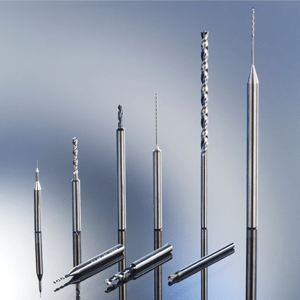The Refinement of Microdrilling
The medical industry pushes the limits of precision for machining and tools. The trend toward less-invasive surgery using smaller parts translates to a need to better control the precision and tolerances of micromachining processes. Above all, any micro cutting application must be highly stable and free of vibration.
Microdrilling refers to the micrometer-scale dimension of the cutting volume produced with each tool path, not the size of the part it is cutting. Microcutting can be used to create miniature, small, or large parts with very precise cuts. BIG KAISER's products are consistent with the industry accepted range for micro drilling: starting diameter of 0.50-2.5 mm (0.002-0.10"), available as micro drills and center drills in steps of 0.010 mm (0.00040"). Below a diameter of 0.05 mm, alternative solutions to hole drilling must be used, such as laser drilling.
Microdrilling requires very high sensitivity and fine resolution in the feed axis. The machines spindle must be capable of high-speed rotation with very low dynamic runout. Machine shops wanting to make the transition to microdrilling should either purchase tools specifically for micromachining or dedicate and qualify a tool on the floor that is capable of very low dynamic run, out and sufficiently fine feeds.
For example, for microdrilling tools, we recommend a maximum runout of less than 0.00025 mm (0.000111 ) total indicated runout (TIR), measured at four times the diameter. TIR is measured in two directions: the radial runout (spindle wobble at the nose) and the axial runout (spindle .movement perpendicular to rotation direction), using non contact capacitance sensor technology. TIR is the distance measured between the largest plus direction and the largest minus direction.
While some users consider shrinkfit technology to be the most reliable method to ensure acceptable runout, our studies conclude that this is not the optimal approach. We suggest inspecting for TIR each time a tool is changed. Precision collets manufactured to Class AA can provide stable runout and ease of tool changeout.
In microdrilling, the concentricity between the shank, drill point, and margins of the tool must be held to near-perfect tolerances. We find that many users choose to hold drills with common shank dimensions (i.e., 3-mm shank and drill diameter), also known as a wire approach. In this case, it is best to grind the drill to ensure runout is low and very stable. The alternative uses standard shank tooling with a variety of drill tip sizes. The wire drill approach features a lower relative manufacturing cost, but requires a wider range of collet sizes to accommodate different diameter 1 drills. In addition, because of the smaller outer diameter, handling is more of a challenge. Surface quality of the tools must be very smooth, so an ultrafine grade of solid carbide, with grain sizes to the nanometer range, is used to ensure high abrasion resistance and high toughness. Tools with ultrafine surface quality will produce more uniform wear across a variety of cutting edges. With more even wear, the force required to evacuate the chips is reduced, and the likelihood that chips can combine with heat to weld to the flutes is minimized.
Matching the material to be drilled to the cutting tool is similar to conventional drilling operations, except that in microdrilling the cutting edges must be very sharp and precisely on-center. Tighter hole tolerances have led to the industry's development of finishing tools, including micro boring and reaming tools, to improve the typical 20 RMS surface finish created with drilling. Once the process basics for microdrilling are in place-including feed control, spindle and toolholder runout, cutter material and geometry, and cut data-microboring and reaming to hold 0.000 l" tolerances becomes a manageable specification.
Finally, coatings deposited by PVD (physical vapor deposition) in the thickness range of <0.001 mm, can be used to minimize the wear on microdrills. However, in our experience such coatings, if misapplied, can result in breakage .. This is because the coating reduces the cutting edge sharpness, thus increases the torque force on the drill. If necessary, consult your cutting tool manufacturer for a PVD coating specialist.



¿Te pareció interesante o útil? Haznos saber tu opinión agregando tus comentarios o preguntas a continuación.